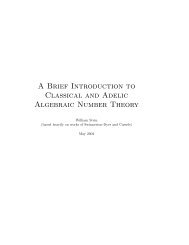A Short Course on Galois Cohomology - William Stein - University of ...
A Short Course on Galois Cohomology - William Stein - University of ...
A Short Course on Galois Cohomology - William Stein - University of ...
You also want an ePaper? Increase the reach of your titles
YUMPU automatically turns print PDFs into web optimized ePapers that Google loves.
for all s ∈ G, that is, s(ba) = ba and thus ba ∈ B G .<br />
Then as ∼ (ba) −1 s(ba) and ba ∈ B G . But a ∈ A so ρ(ba) = ρ(b) = c, so<br />
ba ↦→ c and ba ∈ B G hence c ∈ ρ0(B G ).<br />
Now, we prove exactness at H 1 (G, A). Suppose that ι1 sends [as] to<br />
the trivial element <strong>of</strong> H 1 (G, B). Then there exists a b ∈ B such that as ∼<br />
b −1 s(b) for all s ∈ G. Thus [as] = δ(ρ(b)), which shows that ker(ι1) ⊂ Im(δ).<br />
For the other directi<strong>on</strong>, note that δ(c) is given by as = b −1 s(b) for some b<br />
such that b ↦→ c. But this means that ι1(as) ∼ 1.<br />
Finally, we prove exactness H 1 (G, B). First, note that as ∈ H 1 (G, A)<br />
maps to s ↦→ ρ1(ι1(as)) = 1, since rho◦ι = 1, showing that Im(ι1) ⊂ ker(ρ1).<br />
For the other directi<strong>on</strong>, let bs ∈ H 1 (G, B) such that (s ↦→ ρ1(bs)) ∼ 1. Then<br />
there exists a c ∈ C such that ρ1(bs) = c −1 s(c). We may modify by a lift <strong>of</strong><br />
c so that ρ1(bs) = 1 for all s. It then follows that bs ∈ A for all s, so that<br />
[bs] ∈ Im(ι1).<br />
12 Homology<br />
In this secti<strong>on</strong>, we let G be a group, A an abelian G-module and set DA =<br />
〈s.a − a : a ∈ A, s ∈ G〉, a subgroup <strong>of</strong> A.<br />
We first observe that DA is in fact a G-module,<br />
t.(s.a − a) = t.s.a − t.a = (tst −1 ).(t.a) − t.a ∈ DA.<br />
Thus, A/DA is also a G-module, with trivial G-acti<strong>on</strong>.<br />
Definiti<strong>on</strong> 33. We define H0(G, A) = A/DA, which is the largest quotient<br />
<strong>of</strong> A with trivial G-acti<strong>on</strong>. For q ≥ 1, we also let<br />
Hq(G, A) = Tor Z[G]<br />
q (Z, A)<br />
so that Hq(G, −) are the left-derived functors <strong>of</strong> H0(G, −).<br />
Given a short exact sequence 0 → A → B → C → 0, as before we obtain<br />
a l<strong>on</strong>g exact sequence<br />
· · · → H1(G, A) → H1(G, B) → H1(G, C)<br />
δ<br />
−→ H0(G, A) → H0(G, B) → H0(G, C) → 0.<br />
Example 34. For any group G, we have H1(G, Z) = G/G ′ , the abelianisati<strong>on</strong><br />
<strong>of</strong> G, where G ′ = 〈aba −1 b −1 : a, b ∈ G〉 is the commutator subgroup.<br />
See Serre §VII.4 for a pro<strong>of</strong>.<br />
18
















